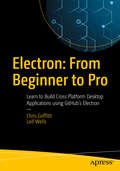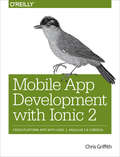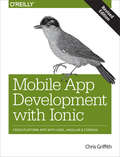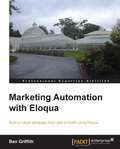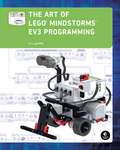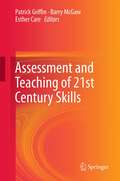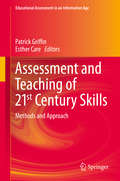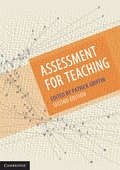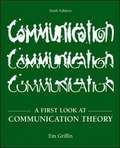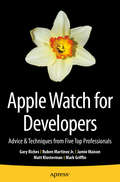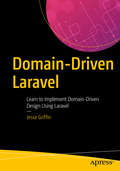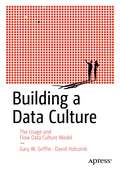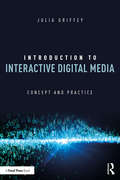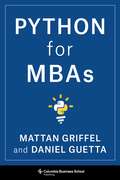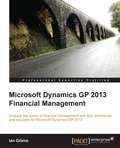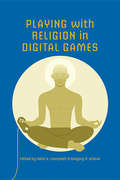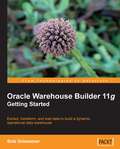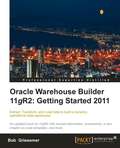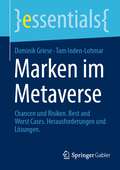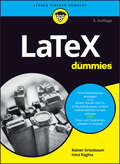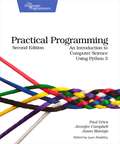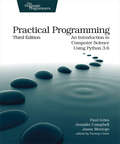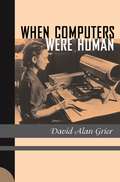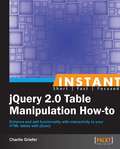- Table View
- List View
Electron: From Beginner to Pro
by Chris Griffith Leif WellsDiscover how to take your existing web development skills and learn how to create desktop applications for macOS, Windows, and Linux, using GitHub's Electron. Learn how to combine the power of Node. js and Chromium to provide a powerful development platform for creating web applications that break free from the browser. Electron: From Beginner to Pro guides you through the capabilities that you have available to create desktop applications. Learn to use features like file system access, create native menus, OS-specific dialogs and more. The authors will show you how to package your application for distribution for multiple platforms and enable auto-updating. What You Will Learn Leverage your knowledge of HTML, CSS and JavaScript Use current web applications for the desktop Create and use Electron's main process and render process to create effective desktop applications Communicate between processes and between windows Build desktop applications that can be updated and distributed Who This Book Is For Web developers looking to leverage their HTML, CSS and JavaScript skills to create desktop widgets and applications. Developers wanting to leverage existing a Web application to extend functionality with a desktop application.
Mobile App Development with Ionic 2: Cross-Platform Apps with Ionic, Angular, and Cordova
by Chris GriffithLearn how to build app store-ready hybrid apps with the Ionic 2, the framework built on top of Apache Cordova (formerly PhoneGap) and Angular. This practical guide shows you how to use Ionic’s tools and services to develop apps with HTML, CSS, and TypeScript, rather than rely on platform-specific solutions found in Android, iOS, and Windows Phone.Author Chris Griffith takes you step-by-step through Ionic’s powerful collection of UI components, and then helps you use it to build three cross-platform mobile apps. Whether you’re new to this framework or have been working with Ionic 1, this book is ideal for beginning, intermediate, and advanced web developers.Understand what a hybrid mobile app is, and what comprises a basic Ionic applicationLearn how Ionic leverages Apache Cordova, Angular, and TypeScript to create native mobile applicationsCreate a Firebase-enabled to-do application that stores data across multiple clientsBuild a tab-based National Park explorer app with Google Map integrationDevelop a weather app with the Darksky weather API and Google’s GeoCode APIDebug and test your app to resolve issues that arise during developmentWalk through steps for deploying your app to native app storesLearn how Ionic can be used to create Progressive Web Apps
Mobile App Development with Ionic, Revised Edition: Cross-Platform Apps with Ionic, Angular, and Cordova
by Chris GriffithLearn how to build app store-ready hybrid apps with the Ionic 2, the framework built on top of Apache Cordova (formerly PhoneGap) and Angular. This revised guide shows you how to use Ionic’s tools and services to develop apps with HTML, CSS, and TypeScript, rather than rely on platform-specific solutions found in Android, iOS, and Windows Phone.Author Chris Griffith takes you step-by-step through Ionic’s powerful collection of UI components, and then helps you use it to build three cross-platform mobile apps. Whether you’re new to this framework or have been working with Ionic 1, this book is ideal for beginning, intermediate, and advanced web developers.Understand what a hybrid mobile app is, and what comprises a basic Ionic applicationLearn how Ionic leverages Apache Cordova, Angular, and TypeScript to create native mobile applicationsCreate a Firebase-enabled to-do application that stores data across multiple clientsBuild a tab-based National Park explorer app with Google Map integrationDevelop a weather app with the Darksky weather API and Google’s GeoCode APIDebug and test your app to resolve issues that arise during developmentWalk through steps for deploying your app to native app storesLearn how Ionic can be used to create Progressive Web Apps
Marketing Automation with Eloqua
by Ben GriffithThis book is a practical guide following a step by step approach to create, edit, customize and upload your marketing campaign using Eloqua.If you are a marketing professional or business analyst who wants to use Eloqua to manage demand generation, lead scoring, e-mail marketing, and build digital marketing campaigns, this book is ideal for you. No previous knowledge of Eloqua is required.
The Art of LEGO MINDSTORMS EV3 Programming
by Terry GriffinWith its colorful, block-based interface, The LEGO® MINDSTORMS® EV3 programming language is designed to allow anyone to program intelligent robots, but its powerful features can be intimidating at first. The Art of LEGO MINDSTORMS EV3 Programming is a full-color, beginner-friendly guide designed to bridge that gap.Inside, you’ll discover how to combine core EV3 elements like blocks, data wires, files, and variables to create sophisticated programs. You’ll also learn good programming practices, memory management, and helpful debugging strategies—general skills that will be relevant to programming in any language.All of the book’s programs work with one general-purpose test robot that you’ll build early on. As you follow along, you’ll program your robot to:–React to different environments and respond to commands–Follow a wall to navigate a maze–Display drawings that you input with dials, sensors, and data wires on the EV3 screen–Play a Simon Says–style game that uses arrays to save your high score–Follow a line using a PID-type controller like the ones in real industrial systemsThe Art of LEGO MINDSTORMS EV3 Programming covers both the Home and Education Editions of the EV3 set, making it perfect for kids, parents, and teachers alike. Whether your robotics lab is the living room or the classroom, this is the complete guide to EV3 programming that you’ve been waiting for.Requirements: One LEGO MINDSTORMS EV3 Home OR Education set (#31313 OR #45544).
Assessment and Teaching of 21st Century Skills: Methods And Approach (Educational Assessment in an Information Age)
by Patrick Griffin Barry Mcgaw Esther CareRapid--and seemingly accelerating--changes in the economies of developed nations are having a proportional effect on the skill sets required of workers in many new jobs. Work environments are often technology-heavy, while problems are frequently ill-defined and tackled by multidisciplinary teams. This book contains insights based on research conducted as part of a major international project supported by Cisco, Intel and Microsoft. It faces these new working environments head-on, delineating new ways of thinking about '21st-century' skills and including operational definitions of those skills. The authors focus too on fresh approaches to educational assessment, and present methodological and technological solutions to the barriers that hinder ICT-based assessments of these skills, whether in large-scale surveys or classrooms. Equally committed to defining its terms and providing practical solutions, and including international perspectives and comparative evaluations of assessment methodology and policy, this volume tackles an issue at the top of most educationalists' agendas.
Assessment and Teaching of 21st Century Skills: Methods and Approach (Educational Assessment in an Information Age)
by Patrick Griffin Esther CareThis second volume of papers from the ATC21STM project deals with the development of an assessment and teaching system of 21st century skills. Readers are guided through a detailed description of the methods used in this process. The first volume was published by Springer in 2012 (Griffin, P. , McGaw, B. & Care, E. , Eds. , Assessment and Teaching of 21st Century Skills, Dordrecht: Springer). The major elements of this new volume are the identification and description of two 21st century skills that are amenable to teaching and learning: collaborative problem solving, and learning in digital networks. Features of the skills that need to be mirrored in their assessment are identified so that they can be reflected in assessment tasks. The tasks are formulated so that reporting of student performance can guide implementation in the classroom for use in teaching and learning. How simple tasks can act as platforms for development of 21st century skills is demonstrated, with the concurrent technical infrastructure required for its support. How countries with different languages and cultures participated and contributed to the development process is described. The psychometric qualities of the online tasks developed are reported, in the context of the robustness of the automated scoring processes. Finally, technical and educational issues to be resolved in global projects of this nature are outlined.
Assessment for Teaching
by Patrick GriffinAssessment for Teaching is a comprehensive and practical introduction to assessment and learning in primary and secondary school settings. This book treats assessment as a source of data that informs teaching strategies. It replaces a deficit model of assessment with a development model: a framework which recognises the importance of identifying what the student is ready to learn. The book also promotes collaboration between teachers in professional learning teams - encouraging the sharing of assessment data and team-based interpretation - to improve student outcomes and to plan goals for students based on a development scale. Each chapter contains: * an exercise for applying the course content to classroom practice * a response template for the exercise * guidelines on assessing the value of the exercise in a professional learning team * a short test for participants to cross-check their understanding of the course content. This is an essential resource for both pre-service and in-service teachers.
Assessment for Teaching
by Patrick GriffinAssessment for Teaching is a comprehensive and practical introduction to assessment and learning in primary and secondary school settings. This book treats assessment as a source of data that informs teaching strategies. It replaces a deficit model of assessment with a development model: a framework which recognises the importance of identifying what the student is ready to learn. The book also promotes collaboration between teachers in professional learning teams - encouraging the sharing of assessment data and team-based interpretation - to improve student outcomes and to plan goals for students based on a development scale. Each chapter contains: - an exercise for applying the course content to classroom practice - a response template for the exercise - guidelines on assessing the value of the exercise in a professional learning team - a short test for participants to cross-check their understanding of the course content This is an essential resource for both pre-service and in-service teachers.
Communication: A First Look At Communication Theory (6th Edition)
by Miriam GriffinThe most widely-used textbook for the communication theory course, "A First Look at Communication Theory" analyzes the major communication theories at a level that is appropriate for both lower- and upper- level courses. The 34 theories represented in the text reflect a mix of foundational and recent scholarship, and strike a balance of scientific and interpretive approaches
Apple Watch for Developers: Advice & Techniques from Five Top Professionals
by Mark Griffin Gary Riches Ruben Martinez Jamie Maison Matt KlostermanApple Watch for Developers: Advice & Techniques from 5 Top Professionals gives you the base-knowledge and valuable secrets you'll need for your own projects from a core team of successful, experienced Apple Watch app-development experts. You'll explore elements such as branding within Watch apps, translating audio data into visual information, taming complex data, mastering environment-driven feature sets, and much more. This book is for developers who already have some knowledge of developing with WatchKit and WatchOS 2, and who are now interested in learning how to use them to create cutting edge Watch apps. It is written by five experienced, industry-leading Apple Watch developers who have created their apps early, and are now ready to pull apart examples to show you how to best create an Apple Watch app. This book will bring your cool Watch ideas to life! What you'll learn * Accept and handle voice recognition on the Apple Watch * Best send data back and forth from iCloud * Perform functions that take very few taps of a screen * Leverage frequency detection * Run your apps natively on the Watch * Work with App Groups to send and receive data * Interface with synced Twitter accounts Who this book is for â-- Apple Watch developers â-- Mobile developers (primarily iOS) Table of Contents Chapter 1: An Apple Watch Introduction Chapter 2: Examining the Stopwatch, Timer and Calendar Chapter 3: Taming Complex Data for the Watch Chapter 4: Examining Home Remote and its Components Chapter 5: Developing Notation - Audio to Musical Score Chapter 6: Building the Infi nitweet Application Chapter 7: Developing Apple Watch Cross-Platform Apps
Domain-Driven Laravel: Learn to Implement Domain-Driven Design Using Laravel
by Jesse GriffinMap concepts and ideas in domain-driven design (DDD) and transpose them into clean, testable, and quality code that is effective alongside the Laravel framework. This book teaches you how to implement the concepts and patterns present in DDD in the real world as a complete web application. With these tactics and concepts in place, you'll engage in a variety of example applications, built from the ground up, and taken directly from real-world domains. Begin by reviewing foundational stepping stones (with small, manageable examples to show proof of concepts as well as illustrations to conceptualize the more complex topics) of both DDD and Laravel. Specifically, such topics as entities, value objects, developing an ubiquitous language, DTOs, and knowledge discovery. Next, you will dive into some more advanced topics of DDD and use these concepts as a guide to make customizations to the default Laravel installation, giving you an understanding of why these alterations are vital to the DDD and Laravel platform. Finally, you will cover the very powerful Eloquent ORM that comes stock with Laravel and understand how it can be utilized to represent entities, handle repositories, and support domain events. Although there is a basic coverage chapter and a setup tutorial for Laravel (along with a high level intro about the components used within it), Domain-Driven Laravel is best suited to readers who have been at least exposed to the framework and have had the opportunity to tinker around with it.What You'll Learn Utilize a blazing-fast rapid development pipeline built from DDD building blocks and facilitated with LaravelImplement value objects, repositories, entities, anti-corruption layers and others using Laravel as a web frameworkApply enhanced techniques for quick prototyping of complex requirements and quality results using an iterative and focused approach Create a base framework (Laravel) that can serve as a template to start off any projectGain insight on which details are important to a project’s success and how to acquire the necessary knowledge Who This Book Is ForIdeal for for frontend/backend web developers, devops engineers, Laravel framework lovers and PHP developers hoping to learn more about either Domain Driven Design or the possibilities with the Laravel framework. Those with a working knowledge of plain PHP can also gain value from reading this book.
Building a Data Culture: The Usage and Flow Data Culture Model
by Gary W. Griffin David HolcombIn today's fast-paced digital landscape, organizations face an ever-increasing volume of data that holds immense potential for driving business success. However, many businesses struggle to harness this potential due to a lack of understanding and effective utilization of data within their culture. This book is a comprehensive guide that unveils the transformative power of data and provides actionable insights to cultivate a data-driven organizational culture.The book emphasizes data strategy and data governance's pivotal role in cultivating a mature data culture using practical insights, frameworks, and best practices. This approach ensures robust data culture structures that uphold data integrity, accessibility, and accountability. These structures operate on the people, processes, and technology through analytics, literacy, governance, process management, and data inventory management.The authors introduce the groundbreaking Usage and Flow Data Culture Model, a unique framework that enables organizations to evaluate and reshape their data culture based on distinct cultural types: Preservationist, Protectionist, Traditionalist, and Progressive. Each culture type is carefully dissected, revealing associated challenges and opportunities, uncovering suitable strategies in the process. Developing a worthy data culture necessitates a shift in mindset and the development of relevant skills across the organization. Building a Data Culture is your roadmap to fostering data literacy, promoting data-driven decision-making, and cultivating a data-driven mindset. What You'll LearnAssess your organization's current data cultureIdentify cultural strengths and weaknesses within your organizationDevelop a data governance programDefine data policies and standards and establish decision-making processesWho This Book is ForProfessionals and leaders across various industries who are interested in building a data culture within their organizations. The typical reader may have a background in data management, analytics, business intelligence, or technology, but the book is designed to be accessible to a wide range of readers with varying levels of expertise.
Introduction to Interactive Digital Media: Concept and Practice
by Julia V. GriffeyThis book offers a clearly written and engaging introduction to the basics of interactive digital media. As our reliance on and daily usage of websites, mobile apps, kiosks, games, VR/AR and devices that respond to our commands has increased, the need for practitioners who understand these technologies is growing. Author Julia Griffey provides a valuable guide to the fundamentals of this field, offering best practices and common pitfalls throughout. The book also notes opportunities within the field of interactive digital media for professionals with different types of skills, and interviews with experienced practitioners offer practical wisdom for readers. Additional features of this book include: An overview of the history, evolution and impact of interactive media; A spotlight on the development process and contributing team members; Analysis of the components of interactive digital media and their design function (graphics, animation, audio, video, typography, color); An introduction to coding languages for interactive media; and A guide to usability in interactive media. Introduction to Interactive Digital Media will help both students and professionals understand the varied creative, technical, and collaborative skills needed in this exciting and emerging field.
Python for MBAs
by Mattan Griffel Daniel GuettaFrom the ads that track us to the maps that guide us, the twenty-first century runs on code. The business world is no different. Programming has become one of the fastest-growing topics at business schools around the world. An increasing number of MBAs are choosing to pursue careers in tech. For them and other professionals, having some basic coding knowledge is a must.This book is an introduction to programming with Python for MBA students and others in business positions who need a crash course. One of the most popular programming languages, Python is used for tasks such as building and running websites, data analysis, machine learning, and natural-language processing. Drawing on years of experience providing instruction in this material at Columbia Business School as well as extensive backgrounds in technology, entrepreneurship, and consulting, Mattan Griffel and Daniel Guetta teach the basics of programming from scratch. Beginning with fundamentals such as variables, strings, lists, and functions, they build up to data analytics and practical ways to derive value from large and complex datasets. They focus on business use cases throughout, using the real-world example of a major restaurant chain to offer a concrete look at what Python can do. Written for business students with no previous coding experience and those in business roles that include coding or working with coding teams, Python for MBAs is an indispensable introduction to a versatile and powerful programming language.
Microsoft Dynamics GP 2013 Financial Management
by Ian GrieveA standard tutorial-based approach covering Microsoft Dynamics GP 2013 and its six financial modules. The book is intended to allow users to improve their system use and workflow by introducing new modules to assist in financial management.This book is for you if you're a Dynamics GP partner, or Dynamics GP user, primarily focused on delivering application optimizations. This book assumes that you have a working knowledge of Microsoft Dynamics GP and have an understanding of the requirements of financial management.
Playing with Religion in Digital Games
by Gregory P. Grieve Heidi A. CampbellShaman, paragon, God-mode: modern video games are heavily coded with religious undertones. From the Shinto-inspired Japanese video game Okami to the internationally popular The Legend of Zelda and Halo, many video games rely on religious themes and symbols to drive the narrative and frame the storyline. Playing with Religion in Digital Games explores the increasingly complex relationship between gaming and global religious practices. For example, how does religion help organize the communities in MMORPGs such as World of Warcraft? What role has censorship played in localizing games like Actraiser in the western world? How do evangelical Christians react to violence, gore, and sexuality in some of the most popular games such as Mass Effect or Grand Theft Auto? With contributions by scholars and gamers from all over the world, this collection offers a unique perspective to the intersections of religion and the virtual world.
Oracle Warehouse Builder 11g: Getting Started
by Bob GriesemerThis easy-to-understand tutorial covers Oracle Warehouse Builder from the ground up, and taps into the author's wide experience as a software and database engineer. Written in a relaxed style with step-by-step explanations, lots of screenshots are provided throughout the book. There are numerous tips and helpful hints throughout that are not found in the original documentation. By following this book, you can use Oracle Warehouse Builder in the best possible way and maximize your learning potential. This book is a good starting point for database engineers, administrators, and architects who are responsible for data warehouse projects and need to design them and load data into them. If you are someone who wants to learn Oracle Warehouse Builder and expand your knowledge of the tool and data warehousing, this is an ideal book for you. No prior data warehouse or database experience is presumed with all new database and data warehouse technical terms and concepts explained in clear easy-to-understand language.
Oracle Warehouse Builder 11g R2: Getting Started 2011
by Bob GriesemerThis easy-to-understand tutorial covers Oracle Warehouse Builder from the ground up, and taps into the author's wide experience as a software and database engineer. Written in a relaxed style with step-by-step explanations, lots of screenshots are provided throughout the book. There are numerous tips and helpful hints throughout that are not found in the original documentation. By following this book, you can use Oracle Warehouse Builder in the best possible way and maximize your learning potential. This book is an update of Oracle Warehouse Builder 11g: Getting Started. This book is a good starting point for database engineers, administrators, and architects who are responsible for data warehouse projects and need to design them and load data into them. If you are someone who wants to learn Oracle Warehouse Builder and expand your knowledge of the tool and data warehousing, this is an ideal book for you. No prior data warehouse or database experience is presumed. All new database and data warehouse technical terms and concepts explained in clear easy-to-understand language.
Marken im Metaverse: Chancen und Risiken. Best and Worst Cases. Herausforderungen und Lösungen (essentials)
by Dominik Griese Tom Inden-LohmarDieses essential zeigt, wie strategisch und konzeptionell ein Markenauftritt im Metaverse entwickelt werden muss und was es dafür braucht. Die Vorgehensweise wird an vier realen Beispielen konkret illustriert. Kaum ein Thema wird gerade so kontrovers wie das Web 3.0 und seine Metaversen diskutiert. Täglich wächst die Zahl der Publikationen, Veranstaltungen und Produkte, die sich damit beschäftigen sowie auch die Zahl der Unternehmen, die auf keinen Fall den abfahrenden Zug verpassen wollen. Mindestens genauso groß ist aber die Zahl derer, die das Ganze für sinnlos ausgegebenes Marketingbudget halten. Es wird Zeit, Licht ins Dunkel der unendlichen Weiten des Web 3.0 zu bringen, Grundlagen und Begriffe zu erklären, Wege und Chancen aufzuzeigen, aber auch laut und deutlich vor den Risiken und Fehlern zu warnen.
LaTeX für Dummies (Für Dummies)
by Rainer Griesbaum Ivica RoginaLaTeX lernen leicht gemacht Von der Installation bis zum Druck: Rainer Griesbaum und Ivica Rogina erklären Ihnen in diesem Buch alles, was Sie zu dem bei Mathematikern, Naturwissenschaftlern und Ingenieuren beliebten Textsatzsystem LaTeX wissen müssen. Bringen Sie mit LaTeX umfangreiche Texte elegant in Form und integrieren Sie anschauliche Abbildungen, übersichtliche Tabellen, informative Fu?noten und schön gestaltete mathematische Formeln. Im Handumdrehen haben Sie ein Inhaltsverzeichnis erstellt, ein Register angelegt oder eine ansprechende Präsentation aufgebaut. Das alles können Sie mit dem Online- Editor Overleaf auch im Internet erledigen, alleine oder gemeinsam mit anderen. Sie erfahren Wie Sie LaTeX und eine bersichtliche Arbeitsumgebung einrichten Wie Sie Texte formatieren, Tabellen erstellen oder Formeln setzen Wie Sie Dokumente strukturieren, Verzeichnisse erstellen und Abbildungen einbinden
Practical Programming: An Introduction to Computer Science Using Python 3
by Paul Gries Jennifer Campbell Jason MontojoThis book is for anyone who wants to understand computer programming. You'll learn to program in a language that' s used in millions of smartphones, tablets, and PCs. You'll code along with the book, writing programs to solve real-world problems as you learn the fundamentals of programming using Python 3. You'll learn about design, algorithms, testing, and debugging, and come away with all the tools you need to produce quality code. In this second edition, we've updated almost all the material, incorporating the lessons we've learned over the past five years of teaching Python to people new to programming. You don't need any programming experience to get started. First, you'll get a detailed introduction to Python and to programming. You'll find out exactly what happens when your programs are executed. Through real-world examples, you'll learn how to work with numbers, text, big data sets, and files. Then you'll see how to create and use your own data types. The incremental examples show you the steps and missteps that happen while developing programs, so you know what to expect when you tackle a problem on your own. Inspired by "How to Design Programs" (HtDP), you'll learn a six-step recipe for designing functions, which helps you as you start to learn the concepts--and becomes an integral part of writing programs by the end. As you learn to use the fundamental programming tools in the first half of the book, you'll see how to document and organize your code so that you and other programmers can more easily read and understand it. Beyond the basics, you'll learn how to ensure that your programs are reliable, and how to work with databases, download data from the web automatically, and build user interfaces. Most importantly, you'll learn how to think like a professional programmer. <P><P><i>Advisory: Bookshare has learned that this book offers only partial accessibility. We have kept it in the collection because it is useful for some of our members. Benetech is actively working on projects to improve accessibility issues such as these.</i>
Practical Programming: An Introduction to Computer Science Using Python 3.6
by Paul Gries Jennifer Campbell Jason MontojoClassroom-tested by tens of thousands of students, this new edition of the bestselling intro to programming book is for anyone who wants to understand computer science. Learn about design, algorithms, testing, and debugging. Discover the fundamentals of programming with Python 3.6--a language that's used in millions of devices. Write programs to solve real-world problems, and come away with everything you need to produce quality code. This edition has been updated to use the new language features in Python 3.6.
When Computers Were Human
by David Alan GrierBefore Palm Pilots and iPods, PCs and laptops, the term "computer" referred to the people who did scientific calculations by hand. These workers were neither calculating geniuses nor idiot savants but knowledgeable people who, in other circumstances, might have become scientists in their own right. When Computers Were Human represents the first in-depth account of this little-known, 200-year epoch in the history of science and technology. Beginning with the story of his own grandmother, who was trained as a human computer, David Alan Grier provides a poignant introduction to the wider world of women and men who did the hard computational labor of science. His grandmother's casual remark, "I wish I'd used my calculus," hinted at a career deferred and an education forgotten, a secret life unappreciated; like many highly educated women of her generation, she studied to become a human computer because nothing else would offer her a place in the scientific world. The book begins with the return of Halley's comet in 1758 and the effort of three French astronomers to compute its orbit. It ends four cycles later, with a UNIVAC electronic computer projecting the 1986 orbit. In between, Grier tells us about the surveyors of the French Revolution, describes the calculating machines of Charles Babbage, and guides the reader through the Great Depression to marvel at the giant computing room of the Works Progress Administration. When Computers Were Human is the sad but lyrical story of workers who gladly did the hard labor of research calculation in the hope that they might be part of the scientific community. In the end, they were rewarded by a new electronic machine that took the place and the name of those who were, once, the computers.
Instant jQuery 2.0 Table Manipulation How-to
by Charlie GrieferFilled with practical, step-by-step instructions and clear explanations for the most important and useful tasks. Get the job done and learn as you go. A how-To book with practical recipes accompanied with rich screenshots for easy comprehension.A short, concise, recipe-based approach that shows you how to manipulate tables using hands-on examples and the most up-to-date techniques in jQuery 2.0.Instant jQuery 2.0 Table Manipulation How-to is aimed at both newcomers and those who have already worked with JavaScript or jQuery. A familiarity with HTML and basic CSS would be beneficial.
